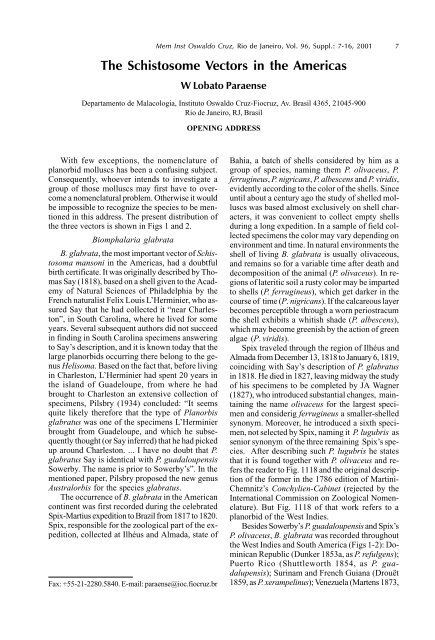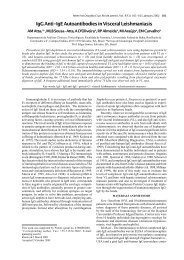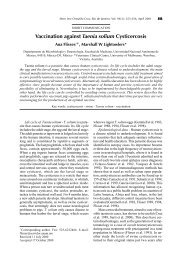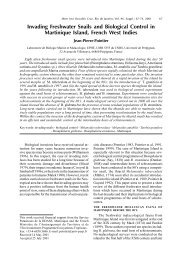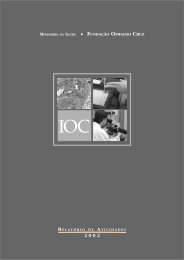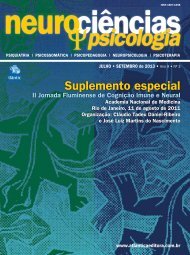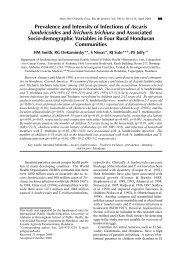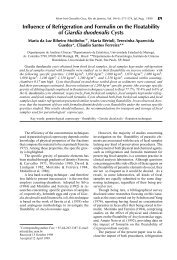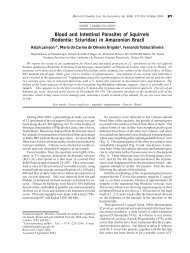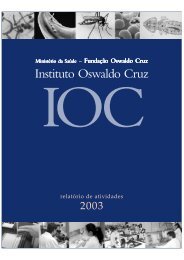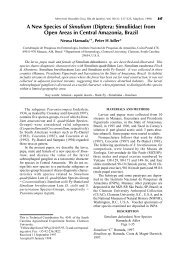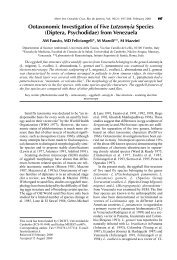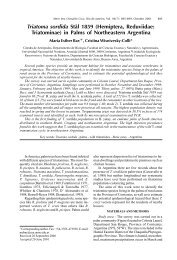The Schistosome Vectors in the Americas - SciELO
The Schistosome Vectors in the Americas - SciELO
The Schistosome Vectors in the Americas - SciELO
Create successful ePaper yourself
Turn your PDF publications into a flip-book with our unique Google optimized e-Paper software.
Mem Inst Oswaldo Cruz, Rio de Janeiro, Vol. 96, Suppl.: 7-16, 2001<br />
<strong>The</strong> <strong>Schistosome</strong> <strong>Vectors</strong> <strong>in</strong> <strong>the</strong> <strong>Americas</strong><br />
W Lobato Paraense<br />
7<br />
Departamento de Malacologia, Instituto Oswaldo Cruz-Fiocruz, Av. Brasil 4365, 21045-900<br />
Rio de Janeiro, RJ, Brasil<br />
OPENING ADDRESS<br />
With few exceptions, <strong>the</strong> nomenclature of<br />
planorbid molluscs has been a confus<strong>in</strong>g subject.<br />
Consequently, whoever <strong>in</strong>tends to <strong>in</strong>vestigate a<br />
group of those molluscs may first have to overcome<br />
a nomenclatural problem. O<strong>the</strong>rwise it would<br />
be impossible to recognize <strong>the</strong> species to be mentioned<br />
<strong>in</strong> this address. <strong>The</strong> present distribution of<br />
<strong>the</strong> three vectors is shown <strong>in</strong> Figs 1 and 2.<br />
Biomphalaria glabrata<br />
B. glabrata, <strong>the</strong> most important vector of Schistosoma<br />
mansoni <strong>in</strong> <strong>the</strong> <strong>Americas</strong>, had a doubtful<br />
birth certificate. It was orig<strong>in</strong>ally described by Thomas<br />
Say (1818), based on a shell given to <strong>the</strong> Academy<br />
of Natural Sciences of Philadelphia by <strong>the</strong><br />
French naturalist Felix Louis L’Herm<strong>in</strong>ier, who assured<br />
Say that he had collected it “near Charleston”,<br />
<strong>in</strong> South Carol<strong>in</strong>a, where he lived for some<br />
years. Several subsequent authors did not succeed<br />
<strong>in</strong> f<strong>in</strong>d<strong>in</strong>g <strong>in</strong> South Carol<strong>in</strong>a specimens answer<strong>in</strong>g<br />
to Say’s description, and it is known today that <strong>the</strong><br />
large planorbids occurr<strong>in</strong>g <strong>the</strong>re belong to <strong>the</strong> genus<br />
Helisoma. Based on <strong>the</strong> fact that, before liv<strong>in</strong>g<br />
<strong>in</strong> Charleston, L’Herm<strong>in</strong>ier had spent 20 years <strong>in</strong><br />
<strong>the</strong> island of Guadeloupe, from where he had<br />
brought to Charleston an extensive collection of<br />
specimens, Pilsbry (1934) concluded: “It seems<br />
quite likely <strong>the</strong>refore that <strong>the</strong> type of Planorbis<br />
glabratus was one of <strong>the</strong> specimens L’Herm<strong>in</strong>ier<br />
brought from Guadeloupe, and which he subsequently<br />
thought (or Say <strong>in</strong>ferred) that he had picked<br />
up around Charleston. ... I have no doubt that P.<br />
glabratus Say is identical with P. guadaloupensis<br />
Sowerby. <strong>The</strong> name is prior to Sowerby’s”. In <strong>the</strong><br />
mentioned paper, Pilsbry proposed <strong>the</strong> new genus<br />
Australorbis for <strong>the</strong> species glabratus.<br />
<strong>The</strong> occurrence of B. glabrata <strong>in</strong> <strong>the</strong> American<br />
cont<strong>in</strong>ent was first recorded dur<strong>in</strong>g <strong>the</strong> celebrated<br />
Spix-Martius expedition to Brazil from 1817 to 1820.<br />
Spix, responsible for <strong>the</strong> zoological part of <strong>the</strong> expedition,<br />
collected at Ilhéus and Almada, state of<br />
Fax: +55-21-2280.5840. E-mail: paraense@ioc.fiocruz.br<br />
Bahia, a batch of shells considered by him as a<br />
group of species, nam<strong>in</strong>g <strong>the</strong>m P. olivaceus, P.<br />
ferrug<strong>in</strong>eus, P. nigricans, P. albescens and P. viridis,<br />
evidently accord<strong>in</strong>g to <strong>the</strong> color of <strong>the</strong> shells. S<strong>in</strong>ce<br />
until about a century ago <strong>the</strong> study of shelled molluscs<br />
was based almost exclusively on shell characters,<br />
it was convenient to collect empty shells<br />
dur<strong>in</strong>g a long expedition. In a sample of field collected<br />
specimens <strong>the</strong> color may vary depend<strong>in</strong>g on<br />
environment and time. In natural environments <strong>the</strong><br />
shell of liv<strong>in</strong>g B. glabrata is usually olivaceous,<br />
and rema<strong>in</strong>s so for a variable time after death and<br />
decomposition of <strong>the</strong> animal (P. olivaceus). In regions<br />
of lateritic soil a rusty color may be imparted<br />
to shells (P. ferrug<strong>in</strong>eus), which get darker <strong>in</strong> <strong>the</strong><br />
course of time (P. nigricans). If <strong>the</strong> calcareous layer<br />
becomes perceptible through a worn periostracum<br />
<strong>the</strong> shell exhibits a whitish shade (P. albescens),<br />
which may become greenish by <strong>the</strong> action of green<br />
algae (P. viridis).<br />
Spix traveled through <strong>the</strong> region of Ilhéus and<br />
Almada from December 13, 1818 to January 6, 1819,<br />
co<strong>in</strong>cid<strong>in</strong>g with Say’s description of P. glabratus<br />
<strong>in</strong> 1818. He died <strong>in</strong> 1827, leav<strong>in</strong>g midway <strong>the</strong> study<br />
of his specimens to be completed by JA Wagner<br />
(1827), who <strong>in</strong>troduced substantial changes, ma<strong>in</strong>ta<strong>in</strong><strong>in</strong>g<br />
<strong>the</strong> name olivaceus for <strong>the</strong> largest specimen<br />
and considerig ferrug<strong>in</strong>eus a smaller-shelled<br />
synonym. Moreover, he <strong>in</strong>troduced a sixth specimen,<br />
not selected by Spix, nam<strong>in</strong>g it P. lugubris as<br />
senior synonym of <strong>the</strong> three rema<strong>in</strong><strong>in</strong>g Spix’s species.<br />
After describ<strong>in</strong>g such P. lugubris he states<br />
that it is found toge<strong>the</strong>r with P. olivaceus and refers<br />
<strong>the</strong> reader to Fig. 1118 and <strong>the</strong> orig<strong>in</strong>al description<br />
of <strong>the</strong> former <strong>in</strong> <strong>the</strong> 1786 edition of Mart<strong>in</strong>i-<br />
Chemnitz’s Conchylien-Cab<strong>in</strong>et (rejected by <strong>the</strong><br />
International Commission on Zoological Nomenclature).<br />
But Fig. 1118 of that work refers to a<br />
planorbid of <strong>the</strong> West Indies.<br />
Besides Sowerby’s P. guadaloupensis and Spix’s<br />
P. olivaceus, B. glabrata was recorded throughout<br />
<strong>the</strong> West Indies and South America (Figs 1-2): Dom<strong>in</strong>ican<br />
Republic (Dunker 1853a, as P. refulgens);<br />
Puerto Rico (Shuttleworth 1854, as P. guadalupensis);<br />
Sur<strong>in</strong>am and French Guiana (Drouët<br />
1859, as P. xerampel<strong>in</strong>us); Venezuela (Martens 1873,
8 <strong>The</strong> <strong>Schistosome</strong> <strong>Vectors</strong> <strong>in</strong> <strong>the</strong> <strong>Americas</strong> • W Lobato Paraense<br />
as P. guadelupensis and P. lugubris); Mart<strong>in</strong>ique<br />
(Mazé 1874, as P. guadeloupensis); Antigua<br />
(Sowerby 1877, as P. antiguensis); Vieques (Germa<strong>in</strong><br />
1921, as P. blauneri); St. Mart<strong>in</strong> (Jones 1923, as P.<br />
antiguensis); St. Kitts (Pilsbry 1934, as A. glabratus<br />
christopherensis); St. Lucia (FC Baker 1945, as A.<br />
glabratus); Curaçao (Kuyp 1949, as A. glabratus<br />
lugubris); Dom<strong>in</strong>ica (Smithsonian Institute Biological<br />
Survey 1964, cited by Prentice 1980); and<br />
Montserrat (Po<strong>in</strong>tier 1975).<br />
Only about a century from its f<strong>in</strong>d<strong>in</strong>g by Spix <strong>in</strong><br />
Bahia was B. glabrata recorded <strong>in</strong> Brazil by F<br />
Baker (1913), as P. guadeloupensis, from <strong>the</strong> lakes<br />
Extremoz and Papari, state of Rio Grande do Norte.<br />
Lutz (1918) studied specimens from <strong>the</strong> states of<br />
Sergipe (as P. olivaceus) and Maranhão (as P.<br />
guadaloupensis). S<strong>in</strong>ce 1916 he asserted that<br />
schistosomiasis did not occur from Rio de Janeiro<br />
southwards for want of a molluscan vector, so much<br />
that for his studies he resorted to feces of pupils<br />
Fig. 1: present distribution of schistosome vectors <strong>in</strong> South America.
Mem Inst Oswaldo Cruz, Rio de Janeiro, Vol. 96, Suppl., 2001<br />
9<br />
Fig. 2: present distribution of Biomphalaria glabrata and B. stram<strong>in</strong>ea <strong>in</strong> <strong>the</strong> Caribbean.<br />
from nor<strong>the</strong>astern states <strong>in</strong> <strong>the</strong> Naval School of Rio<br />
and to “P. olivaceus” from <strong>the</strong> state of Sergipe. In<br />
<strong>the</strong> last-mentioned paper he describes his procedure<br />
for concentration of schistosome eggs, now<br />
often referred to as <strong>the</strong> Hoffman-Pons-Janer’s (1934)<br />
method, proposed 18 years later.<br />
It can not be assured that Lutz was right <strong>in</strong> affirm<strong>in</strong>g<br />
that <strong>the</strong>re was no schistosomiasis from Rio<br />
de Janeiro southwards. Probably <strong>the</strong>re was no diagnosis.<br />
Nowadays it is known that <strong>the</strong>re is B.<br />
glabrata transmitt<strong>in</strong>g S. mansoni <strong>in</strong> sou<strong>the</strong>rn São<br />
Paulo and nor<strong>the</strong>rn Paraná. In Lutz’s collection<br />
<strong>the</strong>re are four specimens labeled P. confusus (but<br />
certa<strong>in</strong>ly B. glabrata) collected on May 5th, 1919<br />
<strong>in</strong> Jatahy (now Jataiz<strong>in</strong>ho, a town <strong>in</strong> nor<strong>the</strong>rn<br />
Paraná) by Souza-Araujo (1919), dur<strong>in</strong>g an extensive<br />
helm<strong>in</strong>thologic survey, from Sept. 1918 to Aug.<br />
1919, which did not reveal any case of schistosomiasis.<br />
It seems certa<strong>in</strong> that spread of <strong>the</strong> disease<br />
to nor<strong>the</strong>rn Paraná is relatively recent. Up to <strong>the</strong><br />
end of last century that region was covered by primary<br />
forest, a condition unfavorable for colonization<br />
by Biomphalaria. About 1867 it began to be<br />
settled by emigrants from São Paulo and M<strong>in</strong>as<br />
Gerais, occupation be<strong>in</strong>g completed <strong>in</strong> <strong>the</strong> 1920’s<br />
with high-scale coffee plantation. <strong>The</strong>re followed<br />
new immigratory waves, now from nor<strong>the</strong>astern<br />
states, <strong>the</strong> seat of <strong>the</strong> oldest foci of schistosomiasis.<br />
<strong>The</strong> association of three factors – devastation<br />
of <strong>the</strong> natural environment by <strong>in</strong>tensive agricultural<br />
exploitation, land occupation by immigrants<br />
of low socioeconomic status, and eutrophication<br />
of <strong>the</strong> bodies of water – would certa<strong>in</strong>ly stimulate<br />
proliferation of <strong>the</strong> preexistent molluscan vector.<br />
Fig. 3 shows <strong>the</strong> progression of B. glabrata <strong>in</strong> <strong>the</strong><br />
state of Paraná toward <strong>the</strong> Paraguayan frontier;<br />
records of successive surveys show that schistosomiasis<br />
did not preexist <strong>in</strong> <strong>the</strong> spotted localities.<br />
In Jan. 1997 a population of B. glabrata was<br />
found <strong>in</strong> Esteio, a locality of Rio Grande do Sul near<br />
Porto Alegre (Carvalho et al. 1998).<br />
Biomphalaria tenagophila<br />
This species was described by Orbigny (1835)<br />
as P. tenagophilus, based on specimens from <strong>the</strong><br />
Argent<strong>in</strong>e prov<strong>in</strong>ce of Corrientes. He found it aga<strong>in</strong><br />
<strong>in</strong> Rio de Janeiro, call<strong>in</strong>g it P. ferrug<strong>in</strong>eus Spix, which<br />
as seen above is a synonym of B. glabrata. He<br />
stated fur<strong>the</strong>r (Orbigny 1841) that he had collected<br />
it from marshes at São Cristóvão district, Rio de<br />
Janeiro city, “where it is very rare”. I searched for<br />
this planorbid <strong>in</strong> São Cristóvão, f<strong>in</strong>d<strong>in</strong>g specimens<br />
that agree with Orbigny’s description, but are <strong>in</strong>dist<strong>in</strong>guishable<br />
from B. tenagophila <strong>in</strong> anatomy<br />
and cross<strong>in</strong>g tests (Paraense 1961b).<br />
In 1856 Dunker described <strong>the</strong> species P.<br />
bahiensis, based on specimens collected <strong>in</strong> Bahia<br />
and Rio de Janeiro. As shown elsewhere (Paraense<br />
1961a, b), Dunker was really deal<strong>in</strong>g with two species:<br />
B. glabrata from Bahia and B. tenagophila<br />
from Rio de Janeiro.
10 <strong>The</strong> <strong>Schistosome</strong> <strong>Vectors</strong> <strong>in</strong> <strong>the</strong> <strong>Americas</strong> • W Lobato Paraense<br />
Fig. 3: distribution of Biomphalaria glabrata over <strong>the</strong> State of Paraná (Brazil), and chronology of westward expansion of<br />
schistosomiasis.<br />
Lutz (1918) admitted that Spix’s P. nigricans<br />
(from Bahia) was identical to <strong>the</strong> planorbid usually<br />
found by him <strong>in</strong> Rio de Janeiro. His op<strong>in</strong>ion was<br />
re<strong>in</strong>forced by <strong>the</strong> fact that he had received specimens,<br />
considered typical by him, from <strong>the</strong> town of<br />
Caravelas, <strong>in</strong> Bahia. For some years several authors<br />
(<strong>in</strong>clud<strong>in</strong>g myself) adopted Lutz’s nomenclature,<br />
treat<strong>in</strong>g as nigricans <strong>the</strong> tenagophila from<br />
Rio de Janeiro southwards. Only <strong>in</strong> 1960 did I notice<br />
that <strong>the</strong> snail from Caravelas is really<br />
tenagophila. In 1994 I collected it <strong>in</strong> Ibirapuã and<br />
Itamaraju, <strong>the</strong> latter, about 100 km north of Caravelas,<br />
be<strong>in</strong>g <strong>the</strong> nor<strong>the</strong>rnmost limit of its distribution.<br />
<strong>The</strong> above-mentioned planorbid from São<br />
Cristóvão was found by Lutz (1918) “<strong>in</strong> <strong>the</strong> same<br />
place as D’ORBIGNY”, and named P. confusus by<br />
him. Lutz reasoned as follows: “<strong>The</strong> observations<br />
of D’ORBIGNY on <strong>the</strong> Planorbis, referred by him<br />
to ferrug<strong>in</strong>eus SPIX, can not apply to olivaceus<br />
SPIX, as <strong>the</strong> dimensions would suggest. Not only<br />
is olivaceus never found <strong>in</strong> Rio (where<br />
Schistosomum is unknown) but <strong>the</strong> species still<br />
exist<strong>in</strong>g <strong>in</strong> São Christovão is our confusus (unable<br />
to transmit <strong>the</strong> parasite). Its largest specimens, but<br />
rarely found <strong>in</strong> Mangu<strong>in</strong>hos, are very like<br />
olivaceus, but do not exceed 25 mm”. Realiz<strong>in</strong>g<br />
later that <strong>the</strong> name confusus had been given by<br />
Rochebrune (1882) to an Oriental planorbid, he<br />
changed it to immunis (Lutz 1923) for obvious reason.<br />
Now it is known that P. immunis is a synonym<br />
of B. tenagophila (see Paraense 1961b), which<br />
ceased be<strong>in</strong>g immune to transmit at least a race of<br />
<strong>the</strong> schistosome (Paraense & Corrêa 1963, 1981).<br />
S<strong>in</strong>ce we are deal<strong>in</strong>g with adaptation of <strong>the</strong><br />
schistosome to a previously refractory host, it<br />
would be worthwhile to remember <strong>the</strong> circumstances.<br />
In 1956, Corrêa et al. detected five<br />
autochtonous cases of schistosomiasis <strong>in</strong><br />
P<strong>in</strong>damonhangaba, a town on <strong>the</strong> Paraíba valley, a<br />
region of <strong>the</strong> state of São Paulo till <strong>the</strong>n free from<br />
<strong>the</strong> disease. <strong>The</strong>y exam<strong>in</strong>ed 408 “A. nigricans” (=B.<br />
tenagophila) from local dra<strong>in</strong><strong>in</strong>g ditches, f<strong>in</strong>d<strong>in</strong>g a<br />
s<strong>in</strong>gle one <strong>in</strong>fected with S. mansoni. Subsequent<br />
<strong>in</strong>vestigation showed that <strong>in</strong> <strong>the</strong> next six years<br />
tenagophila-transmitted schistosomiasis had<br />
spread to seven additional towns <strong>in</strong> <strong>the</strong> valley (To-
Mem Inst Oswaldo Cruz, Rio de Janeiro, Vol. 96, Suppl., 2001<br />
11<br />
ledo 1959, Piza et al. 1959, Piza & Ramos 1960, Piza<br />
et al. 1960a, b, Corrêa et al. 1962).<br />
Investigat<strong>in</strong>g <strong>the</strong> schistosome from <strong>the</strong> Paraíba<br />
valley (<strong>in</strong>fective to tenagophila, as seen above) <strong>in</strong><br />
comparison with <strong>the</strong> schistosome from M<strong>in</strong>as<br />
Gerais (<strong>in</strong>fective to glabrata), we observed that<br />
<strong>the</strong> former was un<strong>in</strong>fective to glabrata and <strong>the</strong> latter<br />
was un<strong>in</strong>fective to tenagophila of <strong>the</strong> valley<br />
(Paraense & Corrêa 1963). Fur<strong>the</strong>r <strong>in</strong>vestigation<br />
(Paraense & Corrêa 1978) showed that 15 out of 20<br />
populations of B. tenagophila from <strong>the</strong> species<br />
range were susceptible to S. mansoni from <strong>the</strong><br />
Paraíba valley (sample SJ, from São José dos Campos).<br />
Compar<strong>in</strong>g <strong>the</strong> relatively lower <strong>in</strong>fection rate<br />
of those populations to those observed <strong>in</strong> B.<br />
glabrata exposed to <strong>the</strong> BH schistosome (from Belo<br />
Horizonte, state of M<strong>in</strong>as Gerais), we concluded<br />
that it might be understood “<strong>in</strong> <strong>the</strong> context of an<br />
ongo<strong>in</strong>g process of adaptation of <strong>the</strong> tenagophila<strong>in</strong>fect<strong>in</strong>g<br />
schistosome by selection through<br />
sucessive passages by <strong>the</strong> snail host”.<br />
F<strong>in</strong>ally, additional experiments (Paraense &<br />
Corrêa 1981) led to <strong>the</strong> conclusions that <strong>the</strong> SJ<br />
schistosome is less adapted to its vector snail than<br />
<strong>the</strong> BH parasite to its own; that <strong>the</strong>y are <strong>in</strong>terfertile,<br />
produc<strong>in</strong>g hybrids <strong>in</strong>fective to BH and SJ snails at<br />
lower rates than <strong>in</strong> <strong>the</strong> sympatric comb<strong>in</strong>ations; and<br />
that <strong>the</strong>y are to be considered biological races ra<strong>the</strong>r<br />
than mere stra<strong>in</strong>s. Now hybridization of <strong>the</strong> two<br />
races is surely tak<strong>in</strong>g place <strong>in</strong> nature as a result of<br />
human migration.<br />
To prevent expansion of schistosomiasis from<br />
<strong>the</strong> Paraíba valley a special office was created that,<br />
<strong>in</strong> spite of adopt<strong>in</strong>g all <strong>the</strong> currently recommended<br />
strategy for snail control, did not accomplish that<br />
purpose. After many years of arduous effort it was<br />
noticed that new cases did not occur westwardly,<br />
notwithstand<strong>in</strong>g <strong>the</strong> presence of <strong>the</strong> vector. Till<br />
<strong>the</strong>n <strong>the</strong> consensus of <strong>the</strong> specialists was that B.<br />
tenagophila ranged westward from São Paulo to<br />
Paraguay through <strong>the</strong> state of Mato Grosso do Sul.<br />
Co<strong>in</strong>cidentally I was <strong>the</strong>n collect<strong>in</strong>g snails <strong>in</strong> Mato<br />
Grosso do Sul, verify<strong>in</strong>g that <strong>the</strong> so-called<br />
tenagophila was really a new species – B.<br />
occidentalis – reproductively isolated from B.<br />
tenagophila (Paraense 1981) and <strong>in</strong>susceptible to<br />
<strong>in</strong>fection with <strong>the</strong> SJ race of S. mansoni (Paraense<br />
& Corrêa 1982). I extended <strong>the</strong> survey to <strong>the</strong><br />
westernmost area of São Paulo, identify<strong>in</strong>g B.<br />
occidentalis <strong>in</strong> five localities. A subsequent review<br />
of that area by <strong>the</strong> state agency for control of endemic<br />
diseases (Vaz et al. 1983) found B.<br />
occidentalis <strong>in</strong> a great majority of 252 biotopes,<br />
and B. tenagophila <strong>in</strong> a s<strong>in</strong>gle one. Thus it was<br />
understood that <strong>the</strong> westward expansion of schistosomiasis<br />
<strong>in</strong> São Paulo was be<strong>in</strong>g stopped by nature<br />
and not by control measures (Fig. 4).<br />
A planorbid of Santos, on <strong>the</strong> coast of São<br />
Paulo, gave rise to great nomenclatural confusion.<br />
Arantes (1923) identified <strong>the</strong> first two cases of autochthonous<br />
schistosomiasis <strong>in</strong> <strong>the</strong> city, also <strong>in</strong><br />
<strong>the</strong> state. He sent specimens of <strong>the</strong> planorbid vector<br />
to Pirajá da Silva, who regarded it as probably P.<br />
centimetralis Lutz (now B. stram<strong>in</strong>ea). Moura<br />
(1945) and P<strong>in</strong>to (1945) identified it as A. glabratus.<br />
Accord<strong>in</strong>g to Cout<strong>in</strong>ho (1949a, b) <strong>the</strong>re would be<br />
ano<strong>the</strong>r unidentified species besides A. glabratus.<br />
Bequaert and Lucena (1951) considered it identical<br />
with <strong>the</strong> African B. alexandr<strong>in</strong>a pfeifferi (Krauss),<br />
which <strong>the</strong>y believed to have been <strong>in</strong>troduced dur<strong>in</strong>g<br />
<strong>the</strong> slave trade. Afterwards Lucena (1953), follow<strong>in</strong>g<br />
Jaeckel’s op<strong>in</strong>ion, considered that snail identical<br />
with A. camerunensis Boettger from Cameroon.<br />
Such identification was firstly denied by Boettger<br />
himself, who assured that <strong>the</strong> snail was Wagner’s<br />
P. lugubris, but agreed later (Lucena 1956) that it<br />
really was his A. camerunensis. Ruiz and Carvalho<br />
(1953) identified two species <strong>in</strong> Santos: A. immunis<br />
(Lutz) and A. nigricans (Spix), <strong>the</strong> former be<strong>in</strong>g much<br />
more frequent and <strong>the</strong> only one <strong>in</strong>fected with S.<br />
mansoni. Exam<strong>in</strong><strong>in</strong>g samples from 10 populations<br />
of that planorbid (Paraense & Deslandes 1956) we<br />
proved <strong>the</strong>m to belong to a s<strong>in</strong>gle species, <strong>in</strong>dist<strong>in</strong>guishable<br />
morphologically (shell and anatomy) and<br />
genetically (cross<strong>in</strong>g experiments) from A.<br />
nigricans (now B. tenagophila).<br />
A surpris<strong>in</strong>g f<strong>in</strong>d of B. tenagophila was at <strong>the</strong><br />
Valle de Condebamba (2,500 m above sea level), <strong>in</strong><br />
<strong>the</strong> sierra Department of Cajamarca, Peru (Paraense<br />
et al. 1964). <strong>The</strong>y were morphologically identical<br />
with <strong>the</strong> Brazilian tenagophila but reproductively<br />
isolated from three stra<strong>in</strong>s of <strong>the</strong> latter, <strong>in</strong>clud<strong>in</strong>g<br />
<strong>the</strong> SJ snail from <strong>the</strong> Paraíba valley. Exposed to <strong>the</strong><br />
BH schistosome <strong>the</strong>y showed an <strong>in</strong>fection rate of<br />
43.3%, with retarded development of <strong>the</strong> parasite,<br />
which did not reach <strong>the</strong> cercarial stage. Contrariwise,<br />
72.7% became heavily <strong>in</strong>fected with <strong>the</strong> SJ<br />
schistosome, cercarial shedd<strong>in</strong>g beg<strong>in</strong>n<strong>in</strong>g 30 to<br />
60 days after exposure to miracidia.<br />
Besides Brazil, Argent<strong>in</strong>a and Peru, B.<br />
tenagophila also occurs <strong>in</strong> Bolivia (Orbigny 1835),<br />
Paraguay (Paravic<strong>in</strong>i 1894) and Uruguay (Marshall<br />
1930, as P. paysanduensis). Its distribution is shown<br />
<strong>in</strong> Fig. 1. So far it was not found outside South<br />
America.<br />
Biomphalaria stram<strong>in</strong>ea<br />
This snail from Cum<strong>in</strong>g’s collection <strong>in</strong> <strong>the</strong> Natural<br />
History Museum, London, is labeled as proceed<strong>in</strong>g<br />
from South America. It was described (not figured) by<br />
Dunker (1848) as P. stram<strong>in</strong>eus. A subsequent description<br />
(Dunker 1850: 42-43), with figures of a specimen,<br />
is <strong>in</strong>sufficient for a sure recognition; he says<br />
that his P. stram<strong>in</strong>eus is very similar to <strong>the</strong> figure of P.
12 <strong>The</strong> <strong>Schistosome</strong> <strong>Vectors</strong> <strong>in</strong> <strong>the</strong> <strong>Americas</strong> • W Lobato Paraense<br />
montanus Orbigny from lake Titicaca but does by no<br />
means adjust to Orbigny’s description of that species.<br />
He also refers to ano<strong>the</strong>r specimen of Cum<strong>in</strong>g’s<br />
collection, from Aconcagua, Chile, hav<strong>in</strong>g doubts<br />
about consider<strong>in</strong>g it a variety of P. stram<strong>in</strong>eus or a<br />
separate species. As to P. montanus, Pilsbry (1924)<br />
and Hubendick (1955) showed that it is a form of P.<br />
andecolus Orbigny, 1835, also from lake Titicaca, anatomically<br />
(Paraense & Deslandes 1957) quite different<br />
from what is now known as B. stram<strong>in</strong>ea. Concern<strong>in</strong>g<br />
<strong>the</strong> specimen from Aconcagua, it is quite probably<br />
<strong>the</strong> snail from that prov<strong>in</strong>ce described by Biese (1951)<br />
as Tropicorbis schmiererianus. <strong>The</strong> likeness between<br />
<strong>the</strong> shells of those nom<strong>in</strong>al species h<strong>in</strong>ders <strong>the</strong> solution<br />
of this problem.<br />
Martens (1859), study<strong>in</strong>g Venezuelan material<br />
from <strong>the</strong> coastal region of lake Maracaibo and <strong>the</strong><br />
environs of Mérida, restricted <strong>the</strong> type locality of<br />
P. stram<strong>in</strong>eus to Lagunilla. In reality <strong>the</strong>re is a town<br />
called Lagunillas (not Lagunilla) <strong>in</strong> ei<strong>the</strong>r region,<br />
and Martens did not clearly <strong>in</strong>dicate <strong>the</strong> place of<br />
his “Lagunilla”. About P. stram<strong>in</strong>eus he only says<br />
(translation): “Lagunilla (see above Ampullaria)<br />
associated with leaves of water plants”. By<br />
“Ampullaria” he means A. eximia Dunker and A.<br />
puncticulata Reeve, both from “Laguna von<br />
Fig. 4: present distribution of Biomphalaria occidentalis and B. tenagophila.
Mem Inst Oswaldo Cruz, Rio de Janeiro, Vol. 96, Suppl., 2001<br />
13<br />
Lagunilla”, “of warm, little wavy, sal<strong>in</strong>e water”. End<strong>in</strong>g<br />
his description of A. eximia, Dunker (1853b)<br />
states that “accord<strong>in</strong>g to <strong>in</strong>formation of Mr. consul<br />
Gruner, from Bremen, <strong>the</strong> locality of this snail is <strong>the</strong><br />
prov<strong>in</strong>ce of Coro, on <strong>the</strong> lake of Maracaibo”. As a<br />
matter of fact, Coro is <strong>the</strong> capital of Falcón state,<br />
and lies about 250 km to <strong>the</strong> nor<strong>the</strong>ast of that lake.<br />
In May 1974 I collected <strong>in</strong> <strong>the</strong> o<strong>the</strong>r Lagunillas,<br />
situated 30 km west of Mérida city, a snail described<br />
as P. meridaensis by Preston (1907). Its shell resembles<br />
that of what is now called B. stram<strong>in</strong>ea,<br />
but anatomically it is <strong>in</strong>dist<strong>in</strong>guishable from B.<br />
prona (see Paraense 1992), described by Martens<br />
himself (1873) from lake Valencia, and whose shell<br />
is notably modified outside <strong>the</strong> lake (Paraense et al.<br />
1992).<br />
Summ<strong>in</strong>g up, almost certa<strong>in</strong>ly Martens’<br />
Lagunilla is <strong>the</strong> Venezuelan village on lake<br />
Maracaibo, whose sal<strong>in</strong>e water, derived from <strong>the</strong><br />
Caribbean sea through <strong>the</strong> gulf of Venezuela, communicates<br />
its sal<strong>in</strong>ity to <strong>the</strong> “Laguna von Lagunilla”<br />
mentioned by him. By <strong>the</strong> way, <strong>in</strong> nor<strong>the</strong>astern Brazil<br />
B. stram<strong>in</strong>ea has been found thriv<strong>in</strong>g <strong>in</strong> sal<strong>in</strong>e<br />
waters, 1-2 g NaCl/liter (Lucena 1946).<br />
It can be affirmed, however, that Cum<strong>in</strong>g had<br />
never been to Venezuela. His shell collect<strong>in</strong>g <strong>in</strong> <strong>the</strong><br />
<strong>Americas</strong> was restricted to <strong>the</strong> Pacific coast, from<br />
<strong>the</strong> island of Chiloé <strong>in</strong> Chile to Conchagua, <strong>in</strong> Honduras<br />
(see Dance 1986: 114).<br />
Martens (1873) refers to specimens of Planorbis<br />
stram<strong>in</strong>eus <strong>in</strong> <strong>the</strong> Museum of Berl<strong>in</strong>: from<br />
Lagunilla, collected by Engel; from Caracas, by<br />
Ernst; and from <strong>the</strong> Brazilian state of Ceará, by Zietz.<br />
Lutz (1928) considered P. stram<strong>in</strong>eus a snail found<br />
by him near Maracay, assert<strong>in</strong>g that it co<strong>in</strong>cided<br />
with <strong>the</strong> species so determ<strong>in</strong>ed by Martens. Of those<br />
localities <strong>the</strong> only one where B. stram<strong>in</strong>ea (as now<br />
def<strong>in</strong>ed) surely occurs is Ceará, where it is widespread.<br />
S<strong>in</strong>ce its presence <strong>in</strong> <strong>the</strong> o<strong>the</strong>r localities<br />
has not been confirmed, <strong>the</strong> name stram<strong>in</strong>ea is<br />
currently applied to <strong>the</strong> planorbid morphologically<br />
identical with <strong>the</strong> form occurr<strong>in</strong>g <strong>in</strong> Ceará.<br />
<strong>The</strong> next record of B. stram<strong>in</strong>ea is F Baker’s<br />
(1913), who collected it <strong>in</strong> lake Papari (Brazilian state<br />
of Rio Grande do Norte) and Ceará, referr<strong>in</strong>g to it as<br />
follows: “<strong>The</strong>re are about half a dozen very similar<br />
forms of Planorbis described from South America,<br />
not figured or imperfectly figured, quite possibly<br />
reducible to one or two species. Planorbis<br />
stram<strong>in</strong>eus Dunker seems to be <strong>the</strong> first of <strong>the</strong>se to<br />
be described”. Moreover, he records <strong>the</strong> occurrence<br />
of B. peregr<strong>in</strong>a (Orbigny, 1835) <strong>in</strong> <strong>the</strong> coastal<br />
region of Ceará, which has never been confirmed:<br />
its nor<strong>the</strong>rn limit is 15°S (Paraense 1966), whereas<br />
<strong>the</strong> sou<strong>the</strong>rn limit of Ceará is 8°S.<br />
Baker’s doubts mentioned above were also felt<br />
by Lutz (1918): “In <strong>the</strong> State of Pernambuco ... <strong>the</strong><br />
largest species of Planorbis are unknown, but a<br />
smaller one is widely spread, as well <strong>in</strong> rivers as <strong>in</strong><br />
ponds. Try<strong>in</strong>g to determ<strong>in</strong>e it, I found considerable<br />
difficulty. It looks somewhat like peregr<strong>in</strong>us<br />
D’ORB. of which F. BAKER mentions a specimen<br />
from Ceará which may belong to our species; <strong>the</strong><br />
true peregr<strong>in</strong>us, however, which I obta<strong>in</strong>ed <strong>in</strong><br />
Montevideo, is larger and differs by <strong>the</strong> form of<br />
<strong>the</strong> last whorl. BAKER also mentions stram<strong>in</strong>eus<br />
DUNKER as a species of Ceará, but its size and<br />
form do not agree, if <strong>the</strong> draw<strong>in</strong>g of REEVE-<br />
SOWERBY be correct. Without deny<strong>in</strong>g that this<br />
species may have been collected before, I do not<br />
th<strong>in</strong>k that it has been well def<strong>in</strong>ed, which obliges<br />
me to give it a name. I call it centimetralis to <strong>in</strong>dicate<br />
<strong>the</strong> size which, <strong>in</strong> this case, helps very much<br />
to recognize it”. (In <strong>the</strong> semiarid region of Brazilian<br />
Nor<strong>the</strong>ast I found specimens measur<strong>in</strong>g 15<br />
mm).<br />
As mentioned above, Lutz (1928) identified as<br />
P. stram<strong>in</strong>eus a planorbid collected by him near<br />
Maracay. S<strong>in</strong>ce he had erected <strong>the</strong> species<br />
centimetralis ten years before, differentiat<strong>in</strong>g it<br />
from stram<strong>in</strong>ea, a doubt rema<strong>in</strong>s about <strong>the</strong> true<br />
identity of those Venezuelan specimens. Such<br />
confusion about B. stram<strong>in</strong>ea and many species of<br />
planorbids and o<strong>the</strong>r molluscs results from <strong>the</strong> fact<br />
of <strong>the</strong>ir descriptions hav<strong>in</strong>g been based exclusively<br />
on shell characters.<br />
Still regard<strong>in</strong>g Venezuela, <strong>in</strong> December 1956<br />
(Paraense 1963) I collected B. stram<strong>in</strong>ea <strong>in</strong> San<br />
Joaquín, state of Carabobo (some specimens shedd<strong>in</strong>g<br />
cercariae of S. mansoni), from a creek at Hacienda<br />
Cura, where members of a family were <strong>in</strong>fected<br />
with <strong>the</strong> parasite. Malek (1969) mentions its presence<br />
<strong>in</strong> Guatire and Guaraymito, states of Miranda<br />
and Aragua, respectively.<br />
B. stram<strong>in</strong>ea is also present <strong>in</strong> Uruguay (Olazarri<br />
1984), Argent<strong>in</strong>a (Paraense 1970) and Paraguay<br />
(Paraense 1970).<br />
Outside South America (Figs 1, 2) B. stram<strong>in</strong>ea<br />
has been recorded <strong>in</strong> Mart<strong>in</strong>ique (Paraense 1970),<br />
Grenada (Richards 1973), Costa Rica (Paraense et<br />
al. 1981), Dom<strong>in</strong>ican Republic (Sodeman Jr et al.<br />
1985), Dom<strong>in</strong>ica (Noblet & Damian 1991) and<br />
Guadeloupe (Po<strong>in</strong>tier et al. 1993).<br />
In <strong>the</strong> Neotropical region <strong>the</strong>re is a planorbid –<br />
B. kuhniana (Cless<strong>in</strong>, 1883) – very similar to B.<br />
stram<strong>in</strong>ea, which so far has proved refractory to<br />
<strong>in</strong>fection with S. mansoni. Orig<strong>in</strong>ally described from<br />
Sur<strong>in</strong>ame, I collected it <strong>in</strong> Paramaribo and <strong>in</strong> localities<br />
on <strong>the</strong> Tocant<strong>in</strong>s river bas<strong>in</strong>, nor<strong>the</strong>rn Brazil<br />
(Paraense 1988), and also <strong>in</strong> Panama (Paraense<br />
1999), where it was named P. isthmicus by Pilsbry<br />
(1920). Samples labeled “B. stram<strong>in</strong>ea” from Venezuela<br />
and Colombia have been received for<br />
identification <strong>in</strong> this laboratory.
14 <strong>The</strong> <strong>Schistosome</strong> <strong>Vectors</strong> <strong>in</strong> <strong>the</strong> <strong>Americas</strong> • W Lobato Paraense<br />
REFERENCES<br />
Arantes A 1923. Sôbre dois casos de schistosomose<br />
autoctones em Santos. An Paulistas Med Cir 11: 95-<br />
96.<br />
Baker F 1913. <strong>The</strong> land and fresh-water mollusks of <strong>the</strong><br />
Stanford Expedition to Brazil. Proc Acad Nat Sci<br />
Phila 66: 618-672 [1914].<br />
Baker FC 1945. <strong>The</strong> Molluscan Family Planorbidae,<br />
University of Ill<strong>in</strong>ois Press, Urbana, 530 pp.<br />
Beck H 1837. Index molluscorum praesentis aevi Musei<br />
Pr<strong>in</strong>cipis Augustissimi Christiani Frederici. Mollusca<br />
Gastraeopoda Pulmonata, Fasc 2: 101-124.<br />
Bequaert JC, Lucena DT 1951. Introdução no Brasil<br />
de duas espécies africanas de caramujos transmissores<br />
da esquistossomose. Rev Brasil Med 8: 167-<br />
170.<br />
Biese WA 1951. Revisión de los moluscos terrestres y<br />
de agua dulce provistos de concha de Chile. Bol Mus<br />
Nacl Hist Nat 25: 115-137.<br />
Carvalho OS, Nunes IM, Caldeira RL 1998. First report<br />
of Biomphalaria glabrata <strong>in</strong> <strong>the</strong> State of Rio<br />
Grande do Sul, Brazil. Mem Inst Oswaldo Cruz 93:<br />
39-40.<br />
Cless<strong>in</strong> S 1883-1886. Die Familie der Limnaeiden<br />
enthaltend die Genera Planorbis, Limnaeus, Physa<br />
und Amphipeplea. In Mart<strong>in</strong>i & Chemnitz,<br />
Systematisches Conchylien-Cab<strong>in</strong>et, ed. 2, Bauer &<br />
Raspe, Nürnberg, p. 29-430.<br />
Corrêa RR, Coda D, Oliveira UA 1956. Um foco<br />
autóctone de esquistossomose no Vale do Paraíba.<br />
Folia Cl<strong>in</strong> Biol 26: 85-90.<br />
Corrêa RR, Piza JT, Ramos AS, Camargo LV 1962.<br />
Planorbídeos do Estado de São Paulo. Sua relação<br />
com a esquistossomose. Arq Hig Saúde Públ 27:<br />
139-159.<br />
Cout<strong>in</strong>ho JO 1949a. Moluscos do gênero Australorbis<br />
Pilsbry, 1934 – (Mollusca Planorbidae). Rev Cl<strong>in</strong><br />
São Paulo 25: 1-6.<br />
Cout<strong>in</strong>ho JO 1949b. Contribuição para o estudo do<br />
hospedador <strong>in</strong>termediário do Schistosoma mansoni<br />
em Santos – São Paulo. Rev Cl<strong>in</strong> São Paulo 25: 11-<br />
18.<br />
Crosse H 1891. Faune malacologique terrestre et fluviatile<br />
de l’île de Sa<strong>in</strong>t-Dom<strong>in</strong>gue. J Conchyliol 39: 69-<br />
211.<br />
Dance SP 1986. <strong>The</strong> Cum<strong>in</strong>gian era, p. 110-131. In SP<br />
Dance, A History of Shell Collect<strong>in</strong>g, EJ Brill-W<br />
Backhuys, Leiden, 265 pp.<br />
Drouët H 1859. Essai sur les mollusques terrestres et<br />
d’eau douce de la Guyane Française. Mém Soc Agr<br />
Sci Arts Belles Lettres Dept Aube 23: 303-405.<br />
Dunker W 1848. Diagnoses specierum novarum generis<br />
Planorbis collectionis Cum<strong>in</strong>gianae. Proc Zool Soc<br />
London 16: 40-43.<br />
Dunker W 1850. Die Familie der Limnaeidae enthaltend<br />
die Genera Planorbis, Limnaeus, Physa und<br />
Amphipeplea. In Mart<strong>in</strong>i & Chemnitz, Systematisches<br />
Conchylien-Cab<strong>in</strong>et, ed. 2, vol 1, pt. 17, Bauer &<br />
Raspe, Nürnberg.<br />
Dunker W 1853a. Limnaeacea nova collectionis<br />
Cum<strong>in</strong>gianae. Proc Zool Soc London 21: 53-54.<br />
Dunker W 1853b. Ampullaria eximia. Zeitschr Malakol<br />
10: 93-95.<br />
Dunker W 1856. Die Familie der Limnaeiden, etc. In<br />
Mart<strong>in</strong>i & Chemnitz, Systematisches Conchylien-<br />
Cab<strong>in</strong>et, Bauer & Raspe, Nürnberg.<br />
Germa<strong>in</strong> L 1921-24. Catalogue of <strong>the</strong> Planorbidae <strong>in</strong> <strong>the</strong><br />
Indian Museum (Natural History), Calcutta. Rec<br />
Indian Museum 21: 1-210.<br />
Hoffman WA, Pons JA, Janer JL 1934. <strong>The</strong> sedimentation-concentration<br />
method <strong>in</strong> schistosomiasis<br />
mansoni. Puerto Rico J Public Health Trop Med 9:<br />
283-291.<br />
Hubendick B 1955. <strong>The</strong> Percy Sladen Trust Expedition<br />
to Lake Titicaca <strong>in</strong> 1937. XVIII. <strong>The</strong> anatomy of <strong>the</strong><br />
Gastropoda. Trans L<strong>in</strong>nean Soc London 1: 309-327.<br />
Jones SB 1923. Intest<strong>in</strong>al bilharziasis <strong>in</strong> <strong>the</strong> West Indies:<br />
<strong>in</strong>termediate host. J Trop Med Hyg 26: 253-254.<br />
Kuyp E v d 1949. Planorbidae records of <strong>the</strong> Ne<strong>the</strong>rlands<br />
Antilles. Am J Trop Med 29: 259-261.<br />
Lucena DT 1946. Esboço ecológico do A. (N.)<br />
tarsimaculatus Goeldi, 1905, no Nordeste Brasileiro.<br />
Folha Méd 27: 1-46.<br />
Lucena DT 1953. Sôbre um planorbídeo da África<br />
ocidental <strong>in</strong>troduzido na América do Sul. Rev Zool<br />
Botan Afr 48: 176-178.<br />
Lucena DT 1956. Resenha Sistemática dos Planorbídeos<br />
Brasileiros. Gráfica Editora do Recife, 104 pp.<br />
Lutz A 1916. Observações sobre a evolução do<br />
Schistosomum mansoni. Nota prévia. Brazil-Méd<br />
30: 385-387.<br />
Lutz A 1918. On Brasilian fresh-water shells of <strong>the</strong> genus<br />
Planorbis. Mem Inst Oswaldo Cruz 10: 45-61.<br />
Lutz A 1923. Planorbis immunis n. n. Nautilus 37: 36.<br />
Lutz A 1928. Estudios de zoología y parasitología<br />
venezolanas. Rio de Janeiro.<br />
Malek EA 1969. Studies on “tropicorbid” snails<br />
(Biomphalaria: Planorbidae) from <strong>the</strong> Caribbean and<br />
Gulf of Mexico areas, <strong>in</strong>clud<strong>in</strong>g <strong>the</strong> sou<strong>the</strong>rn United<br />
States. Malacologia 7: 183-209.<br />
Marshall WB 1930. New land and fresh-water mollusks<br />
from South America. Proc US Natl Museum 77: 1-7.<br />
Martens E 1859. Ueber e<strong>in</strong>ige Land- und Süsswasser-<br />
Schnecken aus Venezuela. Malakozool Blätter 6: 59-<br />
66 [1860].<br />
Martens E 1873. Die B<strong>in</strong>nenmollusken Venezuela’s.<br />
Festschrift zur Feier des hundertjährigen Bestehens<br />
der Gesellschaft Naturforschender Freunde zu Berl<strong>in</strong>:<br />
157-225. Ferd. Dümmlers Verlagsbuchhandlung,<br />
Harrwitz und Gossmann, Berl<strong>in</strong>.<br />
Mazé H 1874. Catalogue des coquilles terrestres et<br />
fluviatiles recueillies, à la Mart<strong>in</strong>ique, en 1873. J<br />
Conchyliol 22: 158-173.<br />
Moura SAL 1945. Schistosomose mansoni autóctone<br />
em Santos. Rev Inst Adolfo Lutz 5 : 279-311.<br />
Noblet GP, Damian RT 1991. On <strong>the</strong> status of<br />
Biomphalaria and Thiara snails and <strong>the</strong> threat of<br />
schistosomiasis and paragonimiasis on Dom<strong>in</strong>ica,<br />
West Indies. J Med Appl Malacol 3: 1-6.<br />
Olazarri J 1984. Biomphalaria stram<strong>in</strong>ea (Dunker, 1848)<br />
(Mollusca: Gasteropoda) en la cuenca del río Uruguay.<br />
Hist Nat (Corrientes) 4: 285-288.<br />
Orbigny A 1835. Synopsis terrestrium et fluviatilium
Mem Inst Oswaldo Cruz, Rio de Janeiro, Vol. 96, Suppl., 2001<br />
15<br />
molluscorum, <strong>in</strong> suo per Americam meridionalem it<strong>in</strong>ere<br />
collectorum. Mag Zool 5, Classe 5 (61-62): 1-<br />
44.<br />
Orbigny A 1841. Voyage dans l’Amérique Méridionale,<br />
1826-1833. Mollusques, P. Bertrand, Strasbourg,<br />
758 pp.<br />
Paraense WL 1961a. <strong>The</strong> nomenclature of Brazilian<br />
planorbids. I. Australorbis glabratus (Say, 1818).<br />
Rev Brasil Biol 21: 287-296.<br />
Paraense WL 1961b. <strong>The</strong> nomenclature of Brazilian<br />
planorbids. II. Australorbis tenagophilus (Orbigny,<br />
1835). Rev Brasil Biol 21: 343-349.<br />
Paraense WL 1963. <strong>The</strong> nomenclature of Brazilian<br />
planorbids. III. Australorbis stram<strong>in</strong>eus (Dunker,<br />
1848). Rev Brasil Biol 23: 1-7.<br />
Paraense WL 1966. <strong>The</strong> synonymy and distribution of<br />
Biomphalaria peregr<strong>in</strong>a <strong>in</strong> <strong>the</strong> Neotropical region.<br />
Rev Brasil Biol 26: 269-296.<br />
Paraense WL 1970. Planorbídeos hospedeiros <strong>in</strong>termediários<br />
do Schistosoma mansoni. In AS Cunha,<br />
Esquistossomose Mansoni, Sarvier & Universidade<br />
de São Paulo, São Paulo, p. 13-30.<br />
Paraense WL 1975. <strong>The</strong> distribution of <strong>the</strong> molluscan<br />
vectors of schistosomiasis <strong>in</strong> <strong>the</strong> <strong>Americas</strong>. Brasilia<br />
Med 11: 11-14.<br />
Paraense WL 1981.Biomphalaria occidentalis sp.n.<br />
from South America (Mollusca Basommatophora<br />
Pulmonata). Mem Inst Oswaldo Cruz 76: 199-211.<br />
Paraense WL 1988. Biomphalaria kuhniana (Cless<strong>in</strong>,<br />
1883), planorbid mollusc from South America. Mem<br />
Inst Oswaldo Cruz 83: 1-12.<br />
Paraense WL 1992. Planorbis meridaensis Preston,<br />
1907 (Gastropoda: Planorbidae), a synonym of<br />
Biomphalaria prona (Martens, 1873). Mem Inst<br />
Oswaldo Cruz 87: 545-548.<br />
Paraense WL 1999. A bird’s eye survey of Central<br />
American planorbid molluscs. Malacol Rev 32 (<strong>in</strong><br />
press).<br />
Paraense WL, Corrêa LR 1963. Susceptibility of<br />
Australorbis tenagophilus to <strong>in</strong>fection with Schistosoma<br />
mansoni. Rev Inst Med Trop S Paulo 5: 23-<br />
29.<br />
Paraense WL, Corrêa LR 1978. Differential susceptibility<br />
of Biomphalaria tenagophila populations to <strong>in</strong>fection<br />
with a stra<strong>in</strong> of Schistosoma mansoni. J<br />
Parasitol 64: 822-826.<br />
Paraense WL, Corrêa LR 1981. Observations on two<br />
biological races of Schistosoma mansoni. Mem Inst<br />
Oswaldo Cruz 76: 287-291.<br />
Paraense WL, Corrêa LR 1982. Unsusceptibility of<br />
Biomphalaria occidentalis to <strong>in</strong>fection with a stra<strong>in</strong><br />
of Schistosoma mansoni. Mem Inst Oswaldo Cruz<br />
77: 55-58.<br />
Paraense WL, Deslandes N 1956. Australorbis nigricans<br />
as <strong>the</strong> transmitter of schistosomiasis <strong>in</strong> Santos, state<br />
of São Paulo. Rev Brasil Biol 8: 235-245.<br />
Paraense WL, Deslandes N 1957. A redescription of<br />
Taphius andecolus (Orbigny,1835) (Pulmonata,<br />
Planorbidae). Rev Brasil Biol 17: 235-243.<br />
Paraense WL, Ibañez N, Miranda H 1964. Australorbis<br />
tenagophilus <strong>in</strong> Peru, and its susceptibility to Schistosoma<br />
mansoni. Am J Trop Med Hyg 13: 534-540.<br />
Paraense WL, Po<strong>in</strong>tier JP, Delay B, Pernot AF, Incani<br />
RN, Balzan C, Chrosciechowski P 1992. Biomphalaria<br />
prona (Gastropoda: Planorbidae): a morphological<br />
and biochemical study. Mem Inst<br />
Oswaldo Cruz 87: 171-179.<br />
Paraense WL, Zeledón R, Rojas G 1981. Biomphalaria<br />
stram<strong>in</strong>ea and o<strong>the</strong>r planorbid molluscs <strong>in</strong> Costa<br />
Rica. J Parasitol 67: 282-283.<br />
Paravic<strong>in</strong>i G 1894. Viaggio del dottor Alfredo Borelli<br />
nella Repubblica Argent<strong>in</strong>a e nel Paraguay. Boll<br />
Musei Zool Anat Comp Univ Tor<strong>in</strong>o 9: 1-10.<br />
Pilsbry HA 1920. Some Auriculidae and Planorbidae from<br />
Panama. Nautilus 30: 76-79.<br />
Pilsbry HA 1924. South American land and fresh-water<br />
mollusks: notes and descriptions. Proc Acad Nat Sci<br />
Phila 76: 49-66.<br />
Pilsbry HA 1934. Review of <strong>the</strong> Planorbidae of Florida,<br />
with notes on o<strong>the</strong>r members of <strong>the</strong> family. Proc<br />
Acad Nat Sci Phila 86: 29-66.<br />
P<strong>in</strong>to C 1945. Sôbre um foco de esquistosomíase mansoni<br />
em culturas de agrião (Nasturtium offic<strong>in</strong>ale) na cidade<br />
de Santos. Rev Brasil Med 2: 820-823.<br />
Piza JT, Ramos AS 1960. Os focos autóctones de esquistossomose<br />
no Estado de São Paulo. Arq Hig<br />
Saúde Públ 25: 261-271.<br />
Piza JT, Ramos AS, Brandão CSH, Figueiredo CG<br />
1959. A esquistossomose no vale do Paraíba (Estado<br />
de São Paulo, Brasil). Observações sobre a doença<br />
em alguns dos seus municípios e a fauna planorbídica<br />
da região. Rev Inst Adolfo Lutz 19: 97-143.<br />
Piza JT, Ramos AS, Brandão CSH, Camargo LSV,<br />
Gonçalves JR 1960a. Descoberta de um foco<br />
autóctone de esquistossomose em Caçapava (Estado<br />
de São Paulo – Brasil). Arq Hig Saúde Públ 25: 181-<br />
184.<br />
Piza JT, Ramos AS, Brandão CSH, Figueiredo CG,<br />
Camargo LSV 1960b. Vale do Paraíba, foco endêmico<br />
de esquistossomose. Arq Hig Saúde Públ 25: 35-40.<br />
Po<strong>in</strong>tier JP 1975. Sur la presence de Biomphalaria<br />
glabrata (Say, 1818) et de Physa cubensis Pfeiffer,<br />
1839 dans l’île de Montserrat (Petites Antilles). Nouv<br />
Agr Antilles-Guyane 1: 242-245.<br />
Po<strong>in</strong>tier JP 1976. Répartition locale et biogéographie<br />
des mollusques dulçaquicoles de la Guadeloupe<br />
(Antilles françaises). Malacol Rev 9: 85-103.<br />
Po<strong>in</strong>tier JP, Paraense WL, Mazille V 1993. Introduction<br />
and spread<strong>in</strong>g of Biomphalaria stram<strong>in</strong>ea (Dunker,<br />
1848) (Mollusca: Pulmonata: Planorbidae) <strong>in</strong><br />
Guadeloupe, French West Indies. Mem Inst Oswaldo<br />
Cruz 88: 449-455.<br />
Prentice MA 1980. Schistosomiasis and its <strong>in</strong>termediate<br />
hosts <strong>in</strong> <strong>the</strong> Lesser Antillean islands of <strong>the</strong><br />
Caribbean. Bull PAHO 14: 258-268.<br />
Preston HB 1907. Descriptions of new species of land<br />
and freshwater shells from Central and South<br />
America. Ann Mag Nat Hist (series 7) 20: 490-498.<br />
Richards CS 1973. A potential <strong>in</strong>termediate host of Schistosoma<br />
mansoni <strong>in</strong> Grenada. J Parasitol 59: 111.<br />
Rochebrune AT 1882. Documents sur la faune<br />
malacologique de la Coch<strong>in</strong>ch<strong>in</strong>e et du Cambodge.<br />
Bull Soc Philomat 6: 35-74.<br />
Ruiz JM, Carvalho JMA 1953. Australorbis immunis
16 <strong>The</strong> <strong>Schistosome</strong> <strong>Vectors</strong> <strong>in</strong> <strong>the</strong> <strong>Americas</strong> • W Lobato Paraense<br />
(Lutz, 1918) hospedeiro <strong>in</strong>termediário de Schistosoma<br />
mansoni na cidade de Santos, Estado de São<br />
Paulo. Mem Inst Butantan 25: 175-176.<br />
Say T 1818. Account of two new genera, and several<br />
new species, of fresh water and land shells. J Acad<br />
Nat Sci Phila 1 : 276-284.<br />
Shuttleworth RJ 1854. Beiträge zur näheren Kenntniss<br />
der Land- und Süsswasser-Mollusken der Insel<br />
Portorico. Mitth Naturf Ges Bern 321-322 : 89-103.<br />
Sodeman Jr. WA, Rodrick GE, Paraense WL, Vargas de<br />
Gomez M. 1985. Biomphalaria stram<strong>in</strong>ea and o<strong>the</strong>r<br />
planorbids <strong>in</strong> <strong>the</strong> Dom<strong>in</strong>ican Republic. Mem Inst<br />
Oswaldo Cruz 80: 453-456.<br />
Souza-Araujo HC 1919. A profilaxia rural no Estado<br />
do Paraná. In Esboço de Geografia Medica, Livraria<br />
Economica, Curitiba, p. 305-309.<br />
Sowerby GB 1877. Monograph of <strong>the</strong> genus Planorbis.<br />
In Reeve: Conchologia Iconica, Vol. 20, L Reeve &<br />
Co., London.<br />
Toledo OM 1959. Casos autóctones de esquistossomose<br />
mansônica em São José dos Campos. Quoted by<br />
Piza et al. (1960a).<br />
Vaz JF, Elmôr MRD, Gonçalves LMC, Ishihata GK<br />
1983. Resultados do levantamento planorbídico da<br />
área de Presidente Prudente – Estado de São Paulo.<br />
Rev Inst Med Trop São Paulo 25: 120-126.<br />
Wagner JA 1827. Testacea fluviatilia brasiliensia. C<br />
Wolff, Monachii, 36 pp.


